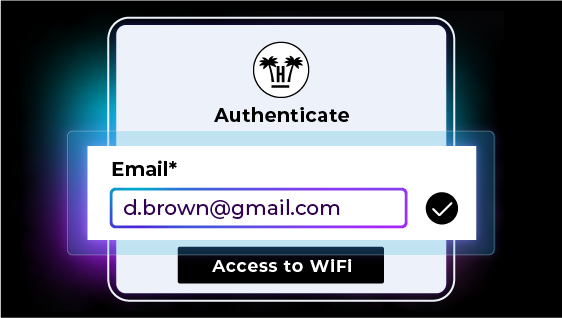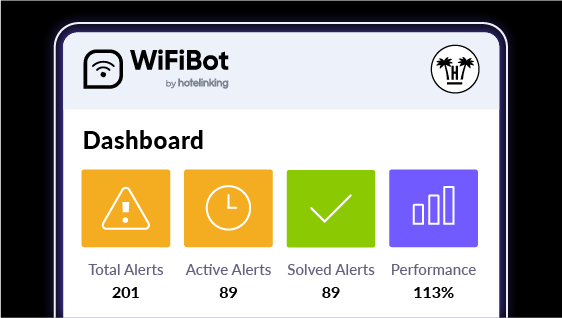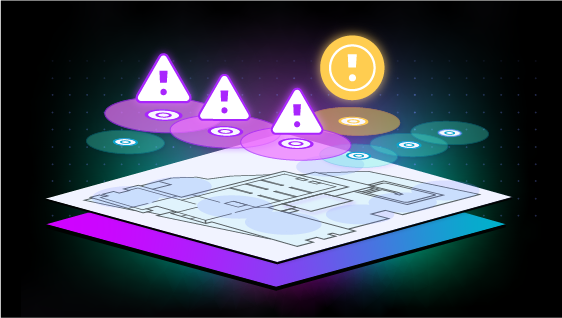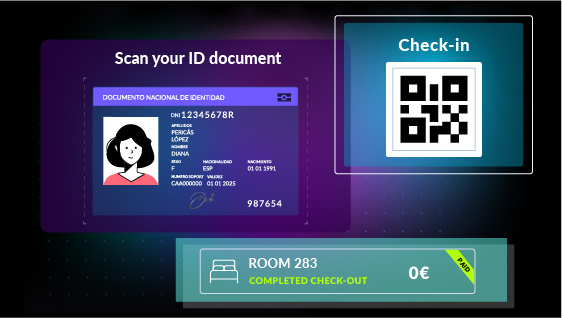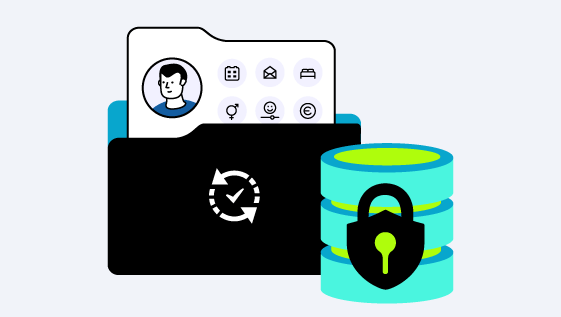
Why Hotel Network Operations Centers Must Evolve: From Reactive Monitoring to Autonomous Network Management
Discover how hotel-network automation is replacing traditional reactive NOCs: shifting from basic monitoring to autonomous operations that boost uptime, transparency and efficiency across hotel chains.
The myth persists that outsourcing network monitoring to traditional NOCs guarantees reliable hotel connectivity. The reality is different: 78% of hotel IT directors report a lack of transparency in incidents managed by these providers. Moreover, guest WiFi complaints directly correlate with 34% of negative reviews.
The fundamental flaw is not (just) technical capability, but the reactive and opaque approach that treats network management as a “black box”. When access points fail at 2 AM, traditional NOCs respond only after guests complain at reception. By then, the damage to guest satisfaction and brand reputation has already occurred. The solution is not “more of the same”, but a clear leap towards autonomous network operations that prevent issues before they impact guests, provide full transparency into network health, and scale intelligently in multi-vendor and multi-property environments, without unnecessary dependencies.
Author’s note: in networking, one of the most common problems is human error. Manual changes without version control, misaligned templates, or late-night emergency tweaks account for a disproportionate share of incidents. My approach — and that of WiFiBot — is to minimise that exposure through automation, standardisation and preventive controls that replace fragile manual processes with repeatable, auditable workflows.
This analysis aims to shed light on why traditional hotel network operation centres have fallen behind, and how autonomous network operations deliver measurable improvements in uptime, transparency, and operational efficiency for international hotel groups.
Key vulnerabilities of traditional hotel NOCs
Traditional NOC services operate with an opacity that undermines effective network management and erodes stakeholder trust.
A recent survey across 150 hotel groups revealed that 78% of IT directors perceive a lack of transparency in incident management by external NOC providers. This “black box” model results in recurring problems: incomplete root-cause analyses, poor resolution documentation, and no real-time visibility into corrective actions.
The transparency deficit creates cascading operational problems. When incidents occur, hotel IT teams receive generic notifications lacking details about the cause of failure, diagnostic procedures performed, or steps taken to resolve the issue. This information gap prevents internal teams from learning from incidents, implementing preventive measures, or providing informed updates to stakeholders.
Erosion of trust is the most significant consequence of black-box operations. IT directors feel excluded from critical decisions and cannot verify whether issues stem from external factors or internal configuration errors. This uncertainty complicates strategic planning and investment prioritisation.
Response-time limitations further aggravate the situation. Traditional NOCs achieve average uptime of 97.2%, with mean resolution times of 2.3 hours for standard problems and 4–6 hours for complex ones. These figures are insufficient in hospitality, where connectivity directly affects the guest experience.
Complaint correlation analysis shows that 34% of network problems managed by traditional NOCs result in guest complaints, indicating that incidents typically impact the guest experience before they are resolved.
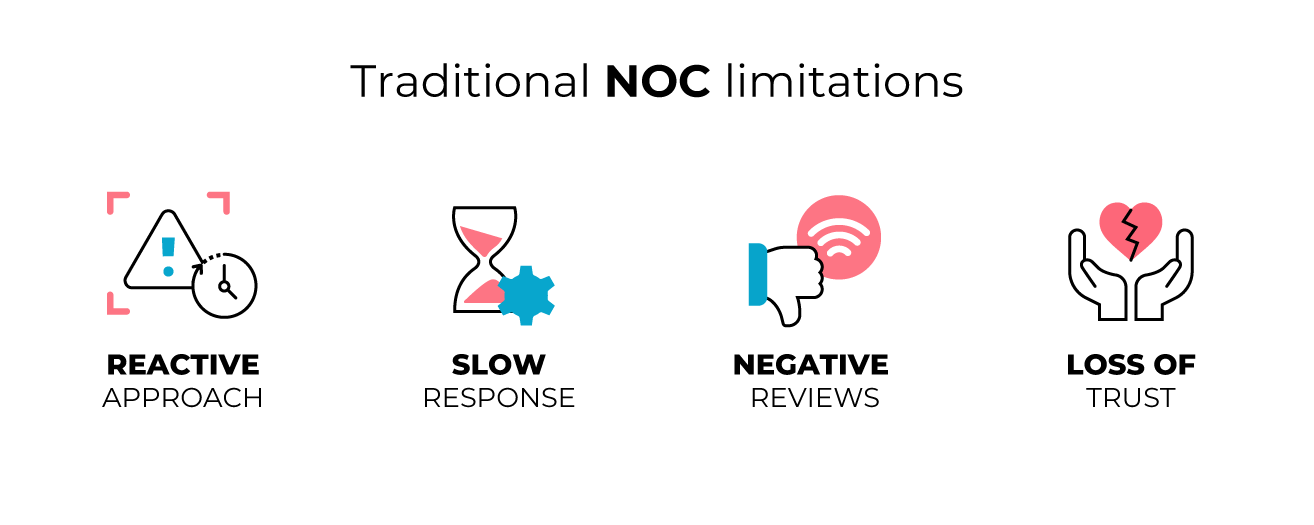
A European hotel group operating in 12 countries suffered these limitations. Before adopting autonomous monitoring, their average uptime was 96.8%, and WiFi complaints represented 28% of all guest service incidents. As their IT director summed it up: «We only knew about network problems when reception was flooded with complaints. Our NOC provider gave us basic uptime reports, but without real visibility into what was happening or how it was resolved».
How autonomous monitoring is transforming hotel networks
The shift from reactive to autonomous operations represents a paradigm change. Autonomous operations combine continuous monitoring, predictive analytics, and automated resolution to prevent issues before they affect guests. The key step is moving from “fire-fighting” to prevention.
- Continuous monitoring: real-time visibility every 30 seconds into performance and status of all elements (APs, switches, controllers, firewalls, OLT/ONT…). Granularity enables detection of degradation before failure thresholds are crossed.
- Predictive analytics: algorithms process historical data, detect pre-failure patterns, and generate proactive alerts. This enables preventive maintenance, configuration optimisation, and capacity planning.
- Automated resolution: immediate corrective actions without human intervention (PoE reboots, parameter restoration, traffic redirection, failover activation). Resolution times drop from hours to minutes, with consistent, auditable responses.
WiFiBot exemplifies this approach as a Level Zero system that handles repetitive tasks automatically and intelligently escalates complex cases to experts. This model frees up engineering time for high-value activities.
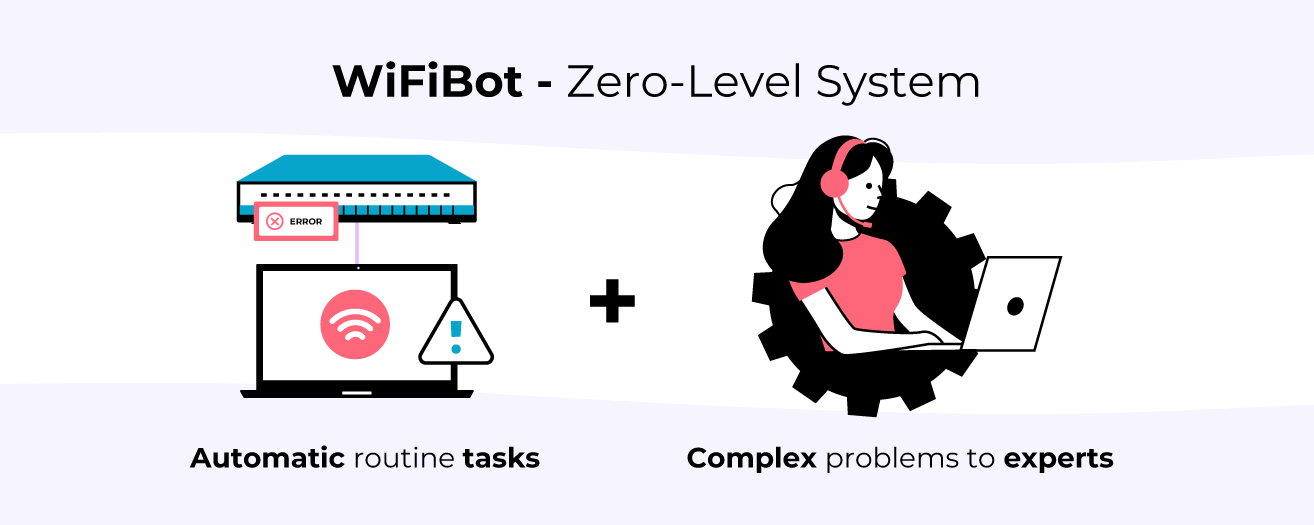
Common automated actions in hotels
- Automatic reboot of unresponsive access points via PoE management.
- Restoration of configurations to optimal parameters when deviations are detected.
- Load balancing to prevent saturation and maintain stable performance.
- Correction of ‘sticky clients’ by reassigning them to optimal bands/APs.
- Verification of DHCP/Captive Portal servers and service restarts.
- Planned firmware update windows and version control.
With these measures, autonomous systems resolve up to 80% of routine incidents without human intervention, and in 2–3 minutes when action is required.
GPON infrastructure: the critical layer often overlooked
Hotel groups increasingly rely on GPON to deliver high-speed internet. However, many traditional NOCs lack visibility into this layer. Specialised monitoring of ONT, OLT, and fibre is indispensable.
- Real-time ONT visibility: optical power levels, error rates, and connection stability.
- Automated ONT replacement: detection, circuit isolation, and guided replacement process — reducing cycles from days to hours, with full traceability.
- Automated VLAN and PON management: baseline comparison and automatic restoration against unwanted changes to avoid configuration drift.
In the case of the European group, incorporating GPON visibility identified 23 faulty ONTs and resolved chronic connectivity issues.
WAN reliability: beyond simple connectivity
Guest experience and hotel systems depend on WAN quality. It is not enough to say “it’s up”: latency, jitter, loss, and throughput must be measured and acted upon.
- Packet loss detection and resolution: even with ‘active’ connectivity, performance may be poor. The system redirects traffic, enforces failover, or adjusts QoS automatically.
- Multi-line failover and balancing: automatic traffic redistribution when thresholds are exceeded; failover in seconds, not minutes.
- Provider SLA compliance: comparable historicals to renegotiate contracts, replace underperforming links, and plan capacity.
In the cited group, 15% of links failed to meet contracted SLAs; the data enabled renegotiation and replacement, improving average performance by 23%.
Unified management in multi-vendor environments
Hotel networks combine different manufacturers and hardware generations. An agnostic platform eliminates silos and provides unified visibility without losing advanced vendor-specific functions.
- Integration via APIs/Protocols: SNMP, SSH, REST, and proprietary protocols for deep metrics and actions.
- Single control panel: one interface for the entire infrastructure reduces complexity and training.
- Operational standardisation: abstraction of differences and enforcement of consistent policies with point access to native capabilities when needed.
Real example: coexistence of Cisco, Aruba, Ruckus, and Huawei GPON managed from a single unified view.
Transforming IT work: from reactive to strategic
Automation eliminates repetitive tasks and frees up time for high-impact projects.
- Automation of common issues: PoE reboots, sticky client corrections, balancing, parameter restoration.
- Intelligent escalation rules: deciding when to escalate to humans based on complexity, impact, and likelihood of success.
- Performance and capacity analysis: identifying future bottlenecks and recommending optimisation.
Typical results: routine incident resolution in 2–3 minutes versus 30–60; 65% reduction in “fire-fighting” time; greater focus on security, guest experience, and operational integrations.
WiFiBot use cases (practical examples)
- Change control and reduction of human error: validated templates, pre-checks, and ‘dry-runs’ before applying in production.
- Configuration comparator (MikroTik, OLT/ONT): section-based difference detection, expandable tree, and baseline restoration.
- Addressing and VLAN audit: cross-checking between configured and active router settings; generation of ADD/MODIFY/REMOVE actions.
- Guided ONT provisioning and replacement: provisioning by serial/LOID, GEM/Service-Port mapping, and profile synchronisation.
- DHCP/Portal supervision: watchdog of critical services with restart and contextual alerts.
- Multi-site deployment orchestration: site-based policies and automation of recurring tasks.
- Planned firmware maintenance: change windows with safe rollback.
- Notifications and webhooks: integration with ITSM/NOC tools and operational channels.
The four maturity levels of the autonomous NOC
- Level 1: basic monitoring with manual escalation
Average uptime: 98.5%. Mean resolution time: 90 minutes. - Level 2: automated resolution of common issues
Reduction of repetitive tasks ≈ 40%. Mean resolution time: 45 minutes. - Level 3: predictive analytics and proactive prevention
Average uptime: 99.5%. Human resolution time: 15 minutes. - Level 4: autonomous operations with strategic oversight
Average uptime: 99.7%. Mean resolution time: 28 minutes. Reduction in connectivity complaints: 67%.
A European hotel group advanced from level 1 to 3 in six months, achieving 99.7% availability and a 72% reduction in WiFi complaints.
Security and compliance: pillars of the autonomous network
Autonomous operations must comply with strict security requirements and regulations such as GDPR and industry standards.
- GDPR and data minimisation: encryption, access controls, and retention policies aligned with regulation; comprehensive auditability.
- Role-based access control: granular visibility and permissions according to responsibilities.
- Enterprise standards (e.g., SOC 2): end-to-end encryption and tamper-proof audit logs with periodic assessments.
In the European group’s implementation, reinforced auditability and RBAC enabled appropriate delegation of responsibilities with full traceability.
Measuring success: KPIs that matter
Availability and guest satisfaction
Target availability: 99.7% (world-class). This level correlates with an average satisfaction of 8.7/10 versus 6.2/10 in hotels with frequent problems.
Resolution time and automation
Automated fixes < 30 minutes. Human-intervention incidents < 90 minutes. An automation rate > 70% validates Level Zero.
Costs and ROI
Average IT cost reduction of 42%. 15% improvement in satisfaction. 12% reduction in OTA dependency.
Case study
Availability: 96.8% → 99.7%. Resolution: 2.3 h → 28 min. WiFi complaints: −72%. ROI: 200% in 14 months.
Conclusion:
Traditional NOCs are yesterday’s approach: their opacity and reactivity erode guest satisfaction and operational efficiency. Autonomous network operations bring transparency, prevention, and multi-vendor flexibility, while reducing human error through automation and standardisation.
Recommended next steps:
- Audit the current level of transparency and traceability in your network operation.
- Establish availability and performance benchmarks (including WAN and GPON).
- Evaluate monitoring/automation platforms that guarantee measurable improvements in satisfaction and efficiency.
